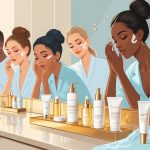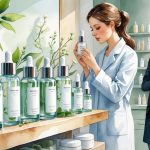Foundation Claims Beauty Editors Quietly Separate From Real Results
Addressing Common Skin Concerns with Foundation
Let’s be real, foundations make wild promises about covering hyperpigmentation or texture or acne, but I always end up poking at my cheek, realizing there’s still stuff peeking through. Sometimes the right formula is shockingly good, almost erasing what you hate most, but there’s always something sneaky left behind if you look close.
Hyperpigmentation Solutions
Coverage for hyperpigmentation? Usually just hype. Every brand says “buildable,” “camouflage,” whatever, but my post-acne spots still show unless I use something thick enough to double as spackle. Dr. Zoe Diana Draelos (yeah, the one Dermatology Times always quotes) says “brightening” ingredients in foundation don’t stick around long enough to matter. I mean, I could’ve guessed.
What actually helps? I’ll layer a heavy-duty foundation—think Estée Lauder Double Wear or Huda Beauty #FauxFilter—right where I need it, or use a color corrector (yellow, peach, sometimes green if I’m feeling wild). That way I can go lighter everywhere else and not look like I’m wearing a mask.
Also, SPF in foundation is a joke. I always put real sunscreen underneath because the SPF rating is based on slapping on, like, a tablespoon per cheek, and who does that? Oh, and using a damp sponge? Sometimes it smooths things out, sometimes it just eats half the product. No one warns you about that.
Tactics for Uneven Texture
“Blurring” foundations are everywhere, but dry patches and bumpy skin don’t care. Powders settle into pores, and two hours later I look like I napped in my makeup. I’ve mixed foundation with a silicone primer (Smashbox Photo Finish is my go-to) to keep it from clinging to flakes, or I’ll switch to cream formulas if my skin’s thirsty.
Read somewhere (Who What Wear, maybe?) that brushing on foundation before bouncing with a sponge actually helps. It does, kind of—brush gives coverage, sponge softens the lines. Still, sometimes I catch weird shadows under certain lights. Nothing covers craters except maybe a soft-focus powder, but if you overdo it, you’re back to chalky territory.
Stacking too many layers is always a disaster, especially under masks or hats. Humidity just ruins everything. Tried a sheet mask before foundation once—helped a bit, but sticky serums will pill if you rush. Why is this so complicated?
Managing Breakouts with Foundation
“Non-comedogenic” is such a lie. Half those formulas still clog my pores. When my skin’s angry, I’ll only use oil-free, fragrance-free stuff. Real Simple did a roundup warning about fragrance, so now I’m paranoid, checking every label for weird botanicals.
Mattifying foundations are supposed to be great for acne-prone skin, but if they don’t move with your face, they crack at the edges. I stick to lightweight liquids, maybe spot-correct with concealer, and always use a clean brush or sponge—old sponges are basically bacteria bombs. Sometimes there’s salicylic acid in makeup, but don’t expect miracles. It’s makeup, not medicine.
Honestly, on bad breakout days, I just dab a little concealer, throw on bright lipstick, and call it. Full coverage makes pimples look worse, especially if you pile on powder. My best trick? Skip foundation if you can, just hit the worst spots and move on. Skin isn’t supposed to look like a mannequin, right?
Top Foundation Picks Editors Truly Recommend
By the time I’ve tried three “must-have” foundations back-to-back, I’m questioning my life choices and my caffeine intake. Cutting through all the PR spin, here’s what actually happens: “24-hour hold” is usually four hours, tops. Moisture-locking? Please. I’ve watched coworkers wipe it off by lunch.
Rare Beauty Liquid Touch Weightless Foundation
Rare Beauty—so much hype. Is it just me, or does that make you suspicious too? I’ve heard people whispering about the Rare Beauty Liquid Touch Weightless Foundation like it’s a secret. It’s $30, feels lighter than Il Makiage, and actually survived a 9-hour day under gross office lights without flaking or turning orange.
Derm friends keep saying it’s non-comedogenic, good for sensitive skin. Is Selena Gomez the reason? Maybe, but let’s be real, cute branding doesn’t guarantee a great formula. This one really does layer up to medium coverage without caking, which never works with drugstore stuff. But if you sweat under a mask, it’ll still transfer. Sorry.
The finish isn’t matte, but not dewy either—just “alive.” Shade range is solid; I swatched ten, no weird orange. No SPF, which dermatologists hate, but honestly, who re-applies foundation for sun protection? For $30, it’s low-drama and just works.
Il Makiage and Other High-End Picks
I fell for that TikTok Il Makiage Foundation quiz thing—100% match, they said. The bottle’s heavy, looks fancy, but for $46, I spent more time blotting my T-zone than with cheaper picks. It does last if you don’t touch your face, but who manages that? Allergy season? Forget it.
Editors toss around Chanel Les Beiges and Westman Atelier sticks—the latter’s great for travel if you care about that. Makeup artists who actually know their stuff (and don’t get paid for reviews) love Saie Glowy Super Skin Tint Foundation for sensitive skin, but even then, my cheeks got shiny before lunch. Monique (who’s always right, apparently) mixes Il Makiage with moisturizer to lighten it, but shouldn’t $46 just be good out of the bottle?
Ingredient lists are a nightmare—phenoxyethanol, titanium dioxide, mica. One backstage artist swears mica is why these look good on camera, but who’s reading ingredient lists at 6 a.m.? Not me. These aren’t serums, they’re not miracles, but if you need to look decent on camera or at an event, they’re less likely to betray you (unless you toss them in your gym bag and they leak everywhere).
Best Drugstore Foundations
I’ve spent way too much time under flickering pharmacy lights, hunting for a cheap win after blowing my budget at Sephora. Maybelline Fit Me, Catrice True Skin, L’Oréal Infallible—always on those best drugstore foundation lists, but let’s be honest, you can feel the difference between glass and plastic bottles.
Catrice has hyaluronic acid and, weirdly, beat out some expensive ones for my dry patches after a late night. Maybelline keeps changing formulas, but it’s never broken me out—my esthetician even shrugged and said, “well, at least it’s fragrance-free.” These show up for oily and combo skin, if you believe editor awards (I don’t, really). Downsides: L’Oréal smells like sunscreen, Revlon shades shift by 3 p.m., and fluorescent lights make everything look chalky.
Don’t expect miracles or bougie packaging, but for desk drawer touch-ups, these work. And if you lose the cap, who cares?



